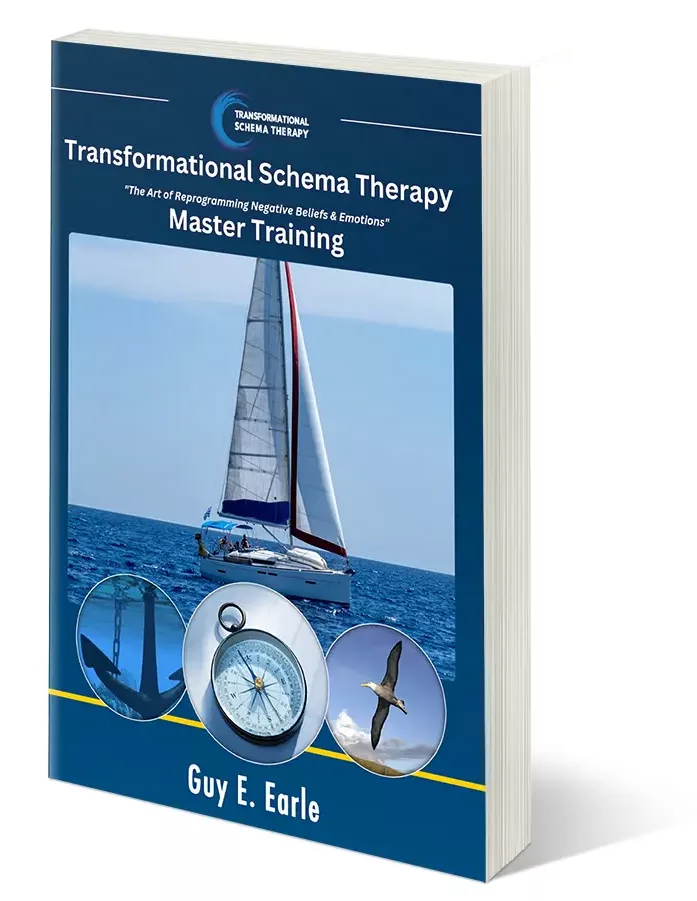This foundational instruction is designed as a collaboration effort that you share with your patient as a means to refresh, revive and rejuvenate for a rapid emotional wellbeing. We review how and why schema’s are formed, and explore successful methods on not only unlocking and disrupting negative schemas, but replacing them to restore your patient’s patterns and provides a fluid transformational change that can impact the trajectory of their lives.
Transformational Schema Training (TSchema) Enhances The Mental Health Practitioner To:

Introduction To The T-Schema Basic Training

Module 1: How The Mind Is Programmed
Experience a powerful journey through the human mind. In modules 1:1 and 1:2 we will explore:
Our ultimate goal is to utilize the skills and knowledge gained through these courses, to disrupt and remove negative constraints, reframe emotional triggers, and replace long-standing negative belief and behavior patterns toward achieving a more fulfilling life.
Experience a powerful journey through the human mind. In modules 1:1 and 1:2 we will explore:
Our ultimate goal is to utilize the skills and knowledge gained through these courses, to disrupt and remove negative constraints, reframe emotional triggers, and replace long-standing negative belief and behavior patterns toward achieving a more fulfilling life.
Module 1:3 – 1:4 explores the limbic system’s role in automatic response. No thinking required, as an emotion is all that is needed to trigger the response that has been set in stone whether it is beneficial or detrimental. We explore limbic imprinting and how the gatekeeper is formed to serve as the protector for survival.
Servo-mechanism, our creative mechanism makes use of stored information, or “memory,” in solving current problems and responding to current situations. We discover how sometimes this “stored data” can remain in control long after any truth or usefulness has evaporated. We advance through the sub-modalities including:
Module 1:3 – 1:4 explores the limbic system’s role in automatic response. No thinking required, as an emotion is all that is needed to trigger the response that has been set in stone whether it is beneficial or detrimental. We explore limbic imprinting and how the gatekeeper is formed to serve as the protector for survival.
Servo-mechanism, our creative mechanism makes use of stored information, or “memory,” in solving current problems and responding to current situations. We discover how sometimes this “stored data” can remain in control long after any truth or usefulness has evaporated. We advance through the sub-modalities including:
Module 1:5 is the introduction to Transformational Schema Therapy.
It first examines how the Gatekeeper emotions imprints. The outcome of this programming builds Schemas. These schemas are the winds that have hijacked the mind, and impact the way life is perceived. The schemas that are targeted in treatment are enduring and self-defeating patterns that typically begin early in life.
Some examples of schema beliefs are: “I’m unlovable,” “I’m a failure,” “People don’t care about me,” “I’m not important,” “Something bad is going to happen,” “People will leave me,” “I will never get my needs met,” “I will never be good enough,” and so on. These schemas are the basis of anxiety, depression, self-doubt and loathing, and thoughts of suicide, to name a few.
Schema Focused Therapy consists of three stages:
Schema-Focused model of treatment is designed to help the person to break these negative patterns of thinking, feeling and behaving, which are often very tenacious, and to develop healthier alternatives to replace them. This module addresses how to deal with each. The goal is to help your client learn to direct the sails of life by learning to redirect the sails of their mind to the destination of their choosing. In short, to reclaim the Helm.
The Rudder of the Mind
The meaningful collaboration of truth and understanding between the Practitioner and Patient. This module focuses on the art of transporting compassion is the bridge that allows one to dock with the patient.
A seaport is a receiving station. It can be a harbor, a town, or a city that allows vessels to dock. A therapist and mental health practitioner, like a seaport, creates clear paths to establish trust through compassion and the art of rapport thus allowing the patient to bring their cargo (the emotional baggage) to a safe docking place.

Module 2: The Pompeii Effect – The Art Of Connection
The modules 2:1 – 2:2 cover the Mental Health practitioner’s ability to be a “Port” where the patient can dock their emotional pains is vital to the healing process. The practitioner becomes the Port – the patient’s safe harbor – where truth is shared and fosters rapport.
Communication is about more than the words we speak. At any given time, we are communicating more than we are saying. In fact, non-verbal communication is more meaningful than the words we use. We explore the processes of communication and building rapport.
In modules 2:3 – 2:4 we cover rapport’s ability to relate to others in a way that creates trust and understanding. It is the ability to see the other’s point of view and get them to understand yours. You don’t have to agree with their point of view or even like it. It makes any form of communication easier. We cover the seven processes on how to build rapport, and its importance. We thoroughly examine the four indicators that identify successful establishment of rapport.
Module 2:5 explores that although every person has all four representational systems operating to some extent, it is important to recognize your patient’s preferred representational system , thus allowing you to communicate in a way that is more similar to how they communicate within their own mind. We cover all the observable cues of a patient and what these cues represent.
The Art of Connection
Journey with your patient to the fulcrum of empowerment and control. The module provides the anchoring script designed to overcome longstanding blockades and a shift of perception. Your patient will gain insight that leads the way to self-transformation
Discover new ways to empower your patient , placing them in the best possible state prior to the TST (Transformational Schema Therapy)

Module 3 : Anchoring The Emotional Soul
In Module 3:1 we discover the skill and practice of anchoring, and the unique properties that provides the ability to feel any state or emotion at any specific time you desire and to help others do the same.
Module 3:2 utilizing the anchoring method to elicitation a time when the patient felt empowered, at peace, and or happy. For simplicity the anchoring elicitation should focus on being empowered. This process relies on the pre-established sense of rapport, bringing the patient into a moment of peace and trust, and move the patient into a state of alert exploration using strategies that utilize all the senses:
One’s lifespan is the length of time between one’s birth and death. A portal is a doorway, gate, or other way to enter into one’s lifespan. We direct our patient on their personal time machine. They are able to navigate to any point within their lifespan. Enabling you to explore and experience events in their past as well as project themselves into the future.
The 3: 3 module covers how the process works within the human psyche, and how to lead your patient to successfully navigate the portal into past experiences and to reframe the future.
Anchoring The Emotional Soul
Exploration of the unconscious mind through the Saboteurs Seeker Search –This is a timeline of all the negative, traumatic, embarrassing, humiliating, tragic, painful, hurtful, failures, illnesses, limiting beliefs, and the like that you have experienced from age 0 to present.
A Schema is, and excavation is the action of excavating something, especially an archaeological site or deep sea excavation.. We want to do an emotional excavation on the soul. That place that has stored every event with its learning within a person.

Module 4: The Marco Polo Effect – Discovery Drivers Of The Negative
“Serious spiritual practice is more than serene walks in the woods, lit candles and incense. You have to be committed. You have to be willing to enter into your own darkness and transcend it.”
-Maria Erving
The main objective introducing the Marco Polo effect is to discover the root calls of the problem. It is the emotional roots that drive negative thoughts, feelings, and behaviors. When the Marco Polo effect is incorporated correctly, it enables us to succinctly, rapidly, and quickly discover the origin of the schema that is producing most if not all of the adverse conditions.
In Module 4:1 introduces the process of uprooting intrusive thoughts and destructive inner chatter. It reveals the most effective methods to search the timeline for timeline of all the negative, traumatic, embarrassing, humiliating, tragic, painful, hurtful, failures, illnesses, limiting beliefs by applying The Saboteur speculation inventory technique.
In module 4:2 focuses on the Saboteur speculation inventory process of tracking negative thoughts and emotions for 7 days. This exercise allows one to become aware of those intrusive thoughts and inner chatter. This is done in a trance State, allowing a process of thought in which the patient is unaware of thoughts that parade across their mind, roaming freely and causing major damage, like a silent killer.
The repeated patterns of negative thoughts, limiting beliefs and emotional Hang-Ups surface through this exercise and produce an analysis of the saboteurs inventory.
Module 4:3 leads to the identifications of common themes and Schema’s from the tracking exercise learned in module 4:2. By using the schema therapy major 18 schemas to help identify maladaptive patterns, this calculation identify the three most common themes (issues) within the seven days of negative thoughts. Then, from the three themes (issues) you lead your patient to the discovery of the one that is causing the most emotional damage.
Schema Therapy is an integrative approach to treatment that combines the best aspects of cognitive-behavioral, experiential, interpersonal and psychoanalytic therapies into one unified model. Schema-Focused Therapy has shown remarkable results in helping people to change negative (“maladaptive”) patterns which they have lived with for a long time, even when other methods and efforts they have tried before have been largely unsuccessful.
Module 4:4 is designed to help the patient break these negative patterns of thinking, feeling and behaving, which are often very tenacious, and to develop healthier alternatives to replace them.
Discovering Negative Drivers
The process of eliminating debilitating schemas and creating new neurological networks that allow one to flow and soar.
The emotional vision board is a projection of their future in their new schema that you in essence help them to create a mental and emotional vision board of coming attractions.

Module 5: Untangling Saboteur Schemas
In module 5:1 we learn the steps to untie the well-knit malfunction and dysfunction of the patient’s emotions.
The Emotional Learning Schema is a Red flag that signifies extreme pain and generates a high priority to avoid at all cost. It is on the outlook for the red flag and when the red flag is detected avoidance is activated instantly.
Module 5:2 explores the purpose and methods of bilateral stimulation and the outcomes to expect.
Bilateral stimulation has great potential in helping to reprocess negative memories. In as one reprocess they are simultaneously relearning. This relearning is the key ingredient in the change process. The breaking of old scripts, which develop into negative patterns. To bring about transformation, one must replace the old negative scripts with new and empowering scripts.
A Bilateral Stimulation Script and a discussion on its use is included in this module.
Module 5: 3 revisits the Lifespan Portal Timeline lesson with an emphasis on the actual steps and processes of how to best navigate the Lifespan Portal Timeline with your patients.
Module 5:4 deals with the process to disenable the old Schema, activate a juxtaposed memory that contrasts with the old Schema and provides more favorable results.
The 5:5 module provides a body scan script with an objective to allow your patient to become aware of the sensations in their body. As recalled memories come to mind, this remind your patient that they are no longer there and are now safe from that situation. This process allows the mind to zone into all the learnings that are taking place through thoughts, emotions, and feelings without judgment.
Module 5:6 cover a favorite aspects of the protocol as it validates the acquired relearning and reprocessing and its successfulness.
The objective is to help the patient to go within and to verify if the new Schema is aligned within them. You are most likely able to know if this is the case if as they activate the new Schema along with the memory and when they are given a 1-7 scale review.
Module 5:7 is the final empowering step in the process in which to the patient, using their new-found Transformational Schema skills, is empowered to view their Lifespan timeline from a safe distance. Not unlike a glass-bottom sailboat that has a clear view of the Ocean Floor beneath. Using this technique, your patient is free to view the future while functioning in their new schema.
The coursework includes a guided self-awareness practice of the Transformational Schema Therapy process to gain deeper insight on the practice.
Sailing Down Wind “Unconscious Mastery”
The path to true healing and wellness as you collaborate with the patient to chart their new course based on their new schema.
Sign Up For The Transformational Schema Therapy Course Today!
Transformational Schema Therapy Basic Training
Train at your own convenience. Experience a lifetime of basic training videos and content anytime.
Live Online Course With Guy Earle
Includes:
$1,424.28
Use coupon code to save $355.82: SAVE25
Special Price: $1,067.21
Recorded Course With Guy Earle
$421.67 Price includes:

The Three Levels Of Transformational Schema Therapy.
Transformational Schema Therapy Basic Training
Level 1–Transformational Schema Therapy Basic Training
Includes:
Transformational Schema Therapy Master Training
Includes:
Transformational Schema Therapy Advanced Training
Includes:
Copyright 2012 – 2024 | Transformational Schema Therapy | All Rights Reserved | Website by Wildwood SEO